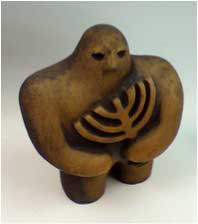The mythic narratives of the Kabbalah may be difficult for us to understand today, but not if we situate them within the deep concerns -- particularly those related to conception and childbirth -- of the kabbalists and ordinary Jews who lived in a time of great uncertainty. Just as bearing children was central to one's identity, it was also rife with peril. Miscarriage, infant mortality, illness, and birth defects were all far more common in the medieval world than they are today. Bearing children was awesome and terrifying.
As, of course, was death. If we are all possessed of life-energy, then what happens to that energy when we die? Ideally, it returns to its source.
The Dybbuk
But sometimes the process goes wrong. In such cases, a variety of ills may befall the soul. The most well-known of these is the phenomenon of the dybbuk, or possession, when one soul "sticks" onto another. Possession by a dybbuk can happen for a number of reasons. Perhaps the departed soul is sinister and the living person innocent. Or, conversely, the departed soul may have been saintly, but wronged by the living; in this case, possession by a dybbuk is essentially punishment (or revenge) for an improper act. Or, apparently, possession may happen almost at random.
The most popular dybbuk in Jewish cultural history is that of S. Ansky's well-known play, The Dybbuk (1920), which describes how the soul of a betrayed man comes back to haunt the body of his betrothed.
The Ibbur
There are other "possession" possibilities as well. A soul may visit a person during sleep, bringing messages from the beyond or prophecies about the future, or it may haunt a place, as in popular ghost stories. Sometimes the soul of a departed righteous person may "impregnate" the soul of a living person, the process described by Lurianic Kabbalah as ibbur -- though unlike the dybbuk, ibbur is usually positive, not negative. Sometimes a righteous soul undergoes ibbur so it can complete a task or perform a mitzvah. Sometimes it does so for the benefit of the "host" soul. Really, ibbur is no different from possession by a dybbuk -- but practically speaking, they are polar opposites, as the former is benign and the other sinister.
In all of these cases, the ordinary processes of life-energy are being diverted, for either positive or negative reasons. And life energy, above all, is powerful. When put to proper ends, the transmission of life energy, by means of sex or supernatural activity, is the godly act of maintaining the cosmic flow. But anything that powerful can also create great evil.
 The Golem
The Golem
Perhaps the most well-known example of this phenomenon, as transmuted by a variety of European sources, is that of the golem, the artificial anthropoid animated by magic. The Talmud relates a tale of rabbis who grew hungry while on a journey -- so they created a calf out of earth and ate it for dinner. The kabbalists determined that the rabbis did this magical act by means of permuting language, primarily utilizing the formulas set forth in the Sefer Yetzirah, or Book of Creation. Just as God speaks and creates, in the Genesis story, so too can the mystic. (The word Abracadabra, incidentally, derives from avra k'davra, Aramaic for "I create as I speak.") Thus, under the rarest of circumstances, a human being may imbue lifeless matter with that intangible, but essential spark of life: the soul.
The kabbalists saw the creation of a golem as a kind of alchemical task, the accomplishment of which proved the adept's skill and knowledge of Kabbalah. In popular legend, however, the golem became a kind of folk hero. Tales of mystical rabbis creating life from dust abounded, particularly in the Early Modern period, and inspired such tales as Frankenstein and "The Sorcerer's Apprentice." Sometimes the golem saves the Jewish community from persecution or death, enacting the kind of heroism or revenge unavailable to powerless Jews. Often, however, Jewish folktales about the golem tell what happens when things go awry -- when the power of life-force goes astray, often with tragic results.
The classic narrative of the golem tells of how Rabbi Judah Loew of Prague (known as the Maharal, 1525-1609) created a golem to defend the Jewish community from anti-Semitic attacks. But eventually, the golem grows fearsome and violent, and Rabbi Loew is forced to destroy it. (Legend tells that the golem remains in the attic of the Altneushul in Prague, ready to be reactivated if needed; this legend reappeared recently in Michael Chabon's The Amazing Adventures of Kavalier & Clay). Likewise in Paul Wegener's expressionist film The Golem (1920), the golem is a brutish creature whose powers are all-too-easily turned to destructive ends.




